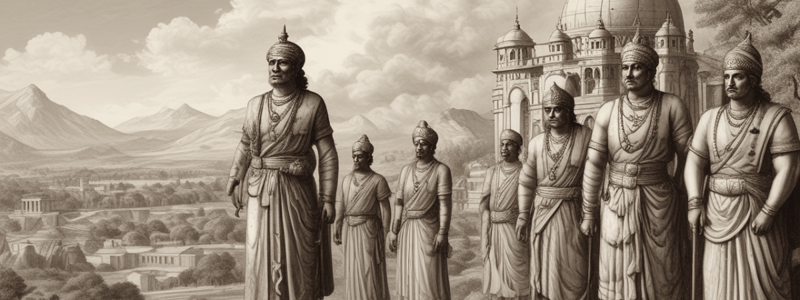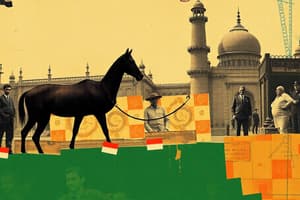Podcast
Questions and Answers
What was the significance of the law passed by the British Parliament on August 2, 1858?
What was the significance of the law passed by the British Parliament on August 2, 1858?
- It abolished the post of Governor General in India.
- It established the post of Secretary of State for India as a ceremonial position.
- It marked the beginning of the East India Company's rule in India.
- It led to the complete takeover of all rights of the East India Company over India. (correct)
What was the title given to Lord Canning, the Governor General of India, after the proclamation by Queen Victoria on November 1, 1858?
What was the title given to Lord Canning, the Governor General of India, after the proclamation by Queen Victoria on November 1, 1858?
- Governor of Madras and Bombay
- Secretary of State for India
- Viceroy of the East India Company
- Viceroy of the British Crown (correct)
What was the primary purpose of the Indian Council Act of 1861?
What was the primary purpose of the Indian Council Act of 1861?
- To establish the East India Company's rule in India
- To abolish the post of Governor General in India
- To introduce the concept of Indian representation in the legislative council (correct)
- To provide for the complete takeover of India by the British Crown
What was the result of the Indian Council Act of 1892?
What was the result of the Indian Council Act of 1892?
What was the significance of the post of Secretary of State for India?
What was the significance of the post of Secretary of State for India?
What was the limitation of the Council's powers under the Indian Council Act of 1861?
What was the limitation of the Council's powers under the Indian Council Act of 1861?
What was the primary purpose of the Government of India Act, 1909?
What was the primary purpose of the Government of India Act, 1909?
What was the result of the discussions between Mr. Montagu and the Indian political leaders in 1917-1918?
What was the result of the discussions between Mr. Montagu and the Indian political leaders in 1917-1918?
What was the limitation of the law-making powers of the Legislature under the Government of India Act, 1919?
What was the limitation of the law-making powers of the Legislature under the Government of India Act, 1919?
What was the DIARCHY system introduced in the provinces under the Government of India Act, 1919?
What was the DIARCHY system introduced in the provinces under the Government of India Act, 1919?
What was the result of the continuous tussle between the elected and nominated members in the provinces under the Government of India Act, 1919?
What was the result of the continuous tussle between the elected and nominated members in the provinces under the Government of India Act, 1919?
What was the significance of the Government of India Act, 1935?
What was the significance of the Government of India Act, 1935?
What was the year when the Indian Government Act got Royal assent?
What was the year when the Indian Government Act got Royal assent?
What was the number of Governor Provinces according to the Indian Government Act?
What was the number of Governor Provinces according to the Indian Government Act?
What was the name of the upper house of the Central Legislature?
What was the name of the upper house of the Central Legislature?
How many members represented British provinces in the Federal Assembly?
How many members represented British provinces in the Federal Assembly?
What was the percentage of the budget that was above the vote of the legislature?
What was the percentage of the budget that was above the vote of the legislature?
What was the power of the Governor-General in the Indian Government Act?
What was the power of the Governor-General in the Indian Government Act?
What was the result of the Indian Government Act in terms of franchise?
What was the result of the Indian Government Act in terms of franchise?
What was the result of the Indian Government Act in terms of control over defense?
What was the result of the Indian Government Act in terms of control over defense?
Flashcards are hidden until you start studying
Study Notes
Constitutional Development in British India
- The British government introduced several acts to govern India, including the Indian Councils Act, 1861, Indian Councils Act, 1892, Government of India Act, 1909, Government of India Act, 1919, and Government of India Act, 1935.
End of East India Company's Rule
- The British Parliament passed a law on August 2, 1858, to take over the East India Company's rights in India.
- The Secretary of State for India was created, and the Secretary of State was empowered to govern India and its revenues.
- On November 1, 1858, Queen Victoria issued a proclamation for the assumption of control of India by the British Crown.
- Lord Canning, the Governor General of India, was given the title of "Viceroy" and became the direct representative of the British Crown.
Indian Council Act, 1861
- This act was the first legislation by the British government in India.
- The Governor General could assign special tasks to members of the Executive Council.
- Important matters were discussed with the Governor General.
- The Council had limited legislative powers.
- Membership of the Council was raised to 12, with half being non-officials nominated for two years.
- Indian representation was provided through nomination.
Indian Council Act, 1892
- The size of the Legislative Council increased.
- Membership in the Central Legislative Council increased to 16 members.
- Provincial representation increased, with 8 to 12 members in Madras and Bombay, and 12 to 20 members in Bengal.
- Limited powers were given to the legislatures, including the ability to ask questions.
- Nominal elections were allowed through special interests.
Government of India Act, 1909 (Minto-Morley Reforms)
- The act expanded the Legislative Councils, with 60 members in the Central Council.
- Provincial councils had a non-official majority.
- Powers of the Councils were increased, including the ability to discuss the budget, present resolutions, and ask questions.
- Executive Councils were formed for Bombay, Madras, and Bengal.
- Elections were held by University Senate, District Boards, Municipal Committees, Zamindars, and Chambers of Commerce.
- Separate electorates were accepted for minorities.
Government of India Act, 1919 (Montagu-Chelmsford Reforms)
- The act introduced a bicameral legislature at the Centre, consisting of the Council of State and the Legislative Assembly.
- The Council of State had 60 members, with 34 elected and 26 nominated members.
- The Legislative Assembly had 145 members, with 105 elected and 40 nominated members.
- Direct elections were introduced with limited franchise.
- Separate electorates were provided for minorities.
- Limited law-making powers were assigned to the Legislature.
- The Legislature had no control over defense, foreign policy, and budget.
- The Governor General remained a powerful office with executive, legislative powers.
Provincial Legislative Councils
- Membership increased, with 70% of members being elected.
- Councils had limited powers, including the ability to reject the budget.
- The Governor General could restore the budget.
Diarchy System in the Provinces
- The act introduced a diarchy system in the provinces, dividing subjects into reserved and transferred categories.
- Reserved subjects included judiciary, canal, land revenue, finance, and press.
- Transferred subjects included local government, education, and public health.
- In case of a dispute, the Governor was entitled to make the final decision.
Government of India Act, 1935
- The act provided a federal system with a centre, 11 Governor Provinces, 6 Chief Commissioner Provinces, and the states willing to join it.
- Three lists of subjects were given, with a powerful centre.
- Federal list included defense, postal services, external affairs, coinage, and communication.
- Provincial list included education, police, local self-government, justice, agriculture, and public service.
- Concurrent list included criminal law, civil marriage, divorce, registration, and bankruptcy.
- Two houses of Central Legislature were established: the Council of State and the Federal Assembly.
- The Council of State had 260 members, with 156 from British provinces and 104 from Indian States.
- The Federal Assembly had 375 members, with 250 from British provinces and 125 from Indian States.
- Limited powers were given to the legislature, including law-making for two lists.
- The Governor General had extensive powers, including the ability to act on advice, exercise independent judgment, and issue ordinances.
- Provincial governments were established, with Governors enjoying similar powers to the Governor General.
- Diarchy was abolished in provinces, and responsible government was formed.
- Provincial legislatures were not unicameral, with bicameral legislatures in six provinces and unicameral in five provinces.
- Franchise was extended but remained restricted on the basis of land revenue, non-transferable property, and education.
Studying That Suits You
Use AI to generate personalized quizzes and flashcards to suit your learning preferences.



